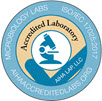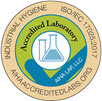Bacteroides
BACTEROIDES
A Better Alternative to Determine Sewage Contamination in Indoor Environments
Diane Miskowski, MPH; Jason Dobranic, Ph.D.
EMSL Analytical, Inc. - Cinnaminson, NJ
Introduction
Coliform and E. coli testing has been used for over 50 years to determine the presence of fecal contamination in recreational water. While the test was originally designed to look for fecal contamination in recreational and drinking water, recently consultants have been using it to look for evidence of sewage contamination in indoor environments. As our understanding of the science improved, it was realized that coliform and E. coli tests were not effective pathogen indicators due to the lag time before sampling occurred. Also, these tests were not consistently accurate or specific due to the die-off of the organisms outside the gastrointestinal (GI) system and their positive detection in non-fecally contaminated environments. Therefore, using these same tests to determine sewage contamination in indoor environmental situations where the ecology is non-aquatic is even more problematic. This paper explains the limitations involved with the current methods, the reasoning behind EPA’s interest in Bacteroides, and EMSL case study evidence to suggest that Bacteroides may be a better test for sewage contamination in indoor environments.
On October 10, 2000 the United States passed The Beaches Environmental Assessment and Coastal Health Act (The Beach Act) which amends the Federal Water Pollution Control Act. These amendments instructed the EPA to: 1.) Study new and faster indicators of human pathogens caused by fecal contamination in recreational waters; and 2.) Study associations between illness and recreational water quality including exposure to fecally contaminated water. Some of the organisms/methods looked at under this new research includes the detection of Bacteroides and Enterococci using Polymerase Chain Reaction (PCR). EMSL was one of the laboratories selected by EPA’s contractor to perform the PCR analyses for this part of the study. Since EMSL was studying the organism as an indicator for fecal contamination in water, we decided to test it as an indicator for fecal contamination in indoor environments.
Background on Fecal Indicator Organisms One gram of feces contains an amazing diversity and amount of organisms. Most of these organisms consist of unculturable bacteria, viruses and protozoans. Some of the organisms found in feces are pathogenic. To perform the testing to identify this vast array of organisms or individual pathogens is impossible and cost-prohibitive.
The solution was to identify a group of bacteria that would be present when feces were present. The presence of these indicator organisms indicates that the potential exists for the presence of fecal pathogens; it does not confirm the presence of these pathogens.
An ideal fecal indicator organism should:
1) Be absolutely specific for fecal contamination
2) Not reproduce in the environment
3) Have a survival time that is the same or greater than the target pathogen
4) Be easily monitored in a very short period of time
Unfortunately the indicator tests that are currently in use do not fit all these criteria. The current indicator tests are:
Total and Fecal Coliforms
Coliforms are not a specific type of bacteria but a biochemical grouping of different types of bacteria that are commonly, but not exclusively, found in mammalian and avian feces. The use of coliforms as fecal indicator organisms started about 90 years ago with the Total Coliform test and progressed to the more specific testing of Fecal Coliforms. Unfortunately, it soon became clear that these tests were not always indicative of
fecal contamination since these organisms commonly occur in soil, sediments, sand, and vegetation where they can multiply. Therefore, the presence of these organisms in water as well as the indoor environment does not necessarily indicate the presence of fecal contamination. These tests are culture tests.
E. coli
E. coli is a subset of bacteria found in the Fecal Coliform group. They are gram negative bacteria that are facultative anaerobes. (These are bacteria that can use oxygen for respiration when it is present but can also survive in the absence of oxygen). E. coli is an inhabitant of the intestinal tract in humans, mammals and birds. Its constant presence in feces has led it to be included in the group of indicator organisms. While it is specific for fecal contamination, there are three inherent problems using E. coli as a confirmation of fecal
contamination: 1) It is outnumbered by other types of fecal bacteria making it more difficult to find; 2) It does not survive for long outside of the gut; 3) It can be found in pristine environments in the tropics. Therefore, the absence or presence of E. coli via a culture test does not absolutely confirm the absence or presence of fecal contamination. The E. coli tests used today as an indication of fecal contamination are commonly culture tests although there are PCR tests for the pathogenic strain E.coli O157:H7 and for enterotoxigenic strains.
Fecal Streptococci and Enterococci
These bacteria belong to a different group than the Coliform group. These are gram positive micro-aerophilic bacteria which thrive in lower concentrations of oxygen. About 50 years ago it was thought that this group of organisms was only found in feces but that has since been disproved. The use of the Fecal Streptococci as an indictor group was displaced by the development of the Fecal Coliform test in the 1950’s.
In 2004, as part of the Beach Act rule, Enterococcus spp. took the place of fecal coliform as the updated federal standard for water quality at recreational coastal waters. The terms fecal streptococci and Enterococci are considered by some to be synonymous. However, the organisms within the fecal streptococci group have been reclassified into the genus Enterococci. Several species of Enterococcus comprise the fecal indicator bacteria, with E. faecalis, E. faecium being the most common.
According to some epidemiological studies, the culture test for Enterococcus spp. has a higher correlation than either the Fecal Coliform or the Fecal Streptococci culture tests for the incidence of waterborne illness; however the Enterococci are not specific to fecal contamination. Enterococci have a ubiquitous distribution in the environment since they can survive a wide variety of environmental conditions. Enterococci are found in soil, food, water and plants in addition to the oral cavity, vagina, and GI tract of humans and animals. Therefore, the presence of Enterococcus is not an absolute indicator of the presence of fecal contamination. The tests for Enterococci are culture and PCR tests. PCR testing is continuing to identify individual species within this genus.
Bacteroides
As part of the Beaches Act, EPA is investigating these bacteria as a replacement fecal indicator species using PCR as the test method. This genus comprises a group of bacteria that are entirely different from the above mentioned groups. These bacteria are obligate anaerobes which means they can only thrive in environments having no oxygen. Since the presence of oxygen will kill these bacteria they will not survive or multiply once they leave the GI tract. They are by far the most predominate bacteria found in the GI tracts of humans and
animals. Bacteroides comprise 1011 organisms per gram of feces (dry weight). They live in a symbiotic relationship with their animal hosts by breaking down the complex molecules from food as it passes through the lower intestine; therefore they survive longer in the GI tract than do coliforms, E.coli or Enterococci.
Due to their sheer numbers, the chance of actually finding Bacteroides is greatly increased compared to other fecal indicator bacteria. Bacteroides outnumber coliforms by 1000:1 and they outnumber E. coli by 10,000:1. Since certain Bacteroides species are only found in feces and are not found in uncontaminated soil, water, food or plants, their presence always indicates fecal pollution.
In addition to the inherent differences in the ecology of the above mentioned groups of indicator organisms, there is also the problem using culturable tests. All culture tests have an inherent bias in that they always underestimate the number of bacteria. This occurrence happens for a number of reasons, but in the instance of recovering fecal indicators, the bias is primarily for two reasons: 1) Some “healthy” bacteria are viable but will not grow in the media prescribed for them; and 2) Bacteria found in the environment are often stressed
thereby making recovery very difficult despite the growth media used. Using PCR, which detects both live and dead bacteria, overcomes this bias.
EMSL performed a limited study on 18 samples to determine the presence of fecal indicator organisms in indoor environmental samples submitted by our clients. We used the standard culture tests to determine the presence or absence of viable coliforms and E. coli. We followed the EPA protocol for quantifying viable as well as non-viable Bacteroides by PCR. The results are presented in the table below:
|
Sample Type
|
Total Coliform
(Presence/Absence)
|
Fecal Coliform
(Presence/Absence)
|
E. coli
(Presence/Absence)
|
Bacteroides PCR (Cell Equivalent Units)
|
|
Water
|
NA
|
NA
|
+
|
1.4 x 102
|
|
Water
|
NA
|
NA
|
-
|
3 x 106
|
|
Swab
|
-
|
-
|
-
|
1.6 x 102
|
|
Swab
|
-
|
-
|
-
|
< 5 CE
|
|
Swab
|
-
|
-
|
-
|
< 5 CE
|
|
Swab
|
-
|
-
|
-
|
ND
|
|
Swab
|
-
|
-
|
-
|
ND
|
|
Swab
|
-
|
-
|
-
|
ND
|
|
Swab
|
-
|
-
|
-
|
1.5 x 102
|
|
Swab
|
-
|
-
|
-
|
4.4 x 104
|
|
Swab
|
-
|
-
|
-
|
1.9 x 102
|
|
Swab
|
-
|
-
|
-
|
ND
|
|
Swab
|
-
|
-
|
-
|
1.7 x 102
|
|
Swab
|
-
|
-
|
-
|
1.5 x 102
|
|
Swab
|
-
|
-
|
-
|
3.3 x 102
|
|
Swab
|
-
|
-
|
-
|
ND
|
|
Soil
|
-
|
-
|
-
|
ND
|
|
Soil
|
-
|
-
|
-
|
ND
|
|
Soil
|
TNTC
|
-
|
-
|
4 x 106
|
TNTC = Too Numerous to Count ND = Not Detected NA = Not Applicable
We chose to use the qualitative presence/absence tests for coliforms and E. coli since these tests have a better chance of recovering environmentally stressed fecal organisms than the membrane filtration tests do. An overview of the data indicates that for the 18 samples tested only two were positive for fecal contamination and the other 12 samples were negative using the traditional fecal indicator tests. Using the Bacteroides test, 12 samples had fecal contamination and 6 had no fecal contamination. This indicates that the Bacteroides test was better at detecting fecal contamination in indoor environmental samples.
Since Bacteroides are associated with humans, mammals and birds, it is conceivable that there may be background levels of these organisms found in bathrooms and in homes with pets. To test the presence of background Bacteroides contamination in areas that had no sewage spills, we sampled 4 inch x 4 inch areas with a sterile swab in a commercial restroom, a commercial cafeteria, a house containing a dog, and a house with no pets. The results were:
Bacteroides Background Levels
|
|
Kitchen CEU's
|
Bathroom CEU's
|
|
No House Pets
|
36
|
ND
|
|
House With Dog
|
ND
|
ND
|
|
Commercial Facility
|
142
|
406
|
Based on the above results we can expect to find low levels of background Bacteroides contamination. The results show that due to the possible transfer of Bacteroides on shoes and contaminated mops, we can find background levels in homes with no pets or evidence of sewage spill. Therefore, samples need to be obtained in non-problem areas of the building where no sewage spills have occurred in addition to the areas in question.
Even though the DNA of Bacteroides can be detected after the organism has died or is viable but not culturable, it will not persist in the environment indefinitely. DNA degrades over time the presence of UV light, and smog. Only good quality, intact DNA can be detected using PCR. The question for indoor environmental consultants is: Will the DNA persist after remediation has been conducted?
To determine the persistence of Bacteroides DNA in the environment after remediation, EMSL ran a lab study to determine if the DNA could be detected after exposure to sodium hypochlorite. In this study we used a common commercial grade of bleach containing 6.15 % of sodium hypochlorite, diluted it 10% by volume, and varied the exposure time. We ran this study using high and low levels of Bacteroides.
Bleach Study - High Bacteroides Levels
|
Bleach Exposure
|
Bacteroides CEU
|
PCR Ct Value
|
|
No Bleach
|
590,811
|
20.20
|
|
5 Minutes
|
216
|
33.93
|
|
10 Minutes
|
162
|
34.43
|
|
30 Minutes
|
ND
|
>40
|
|
60 Minutes
|
7
|
39.89
|
|
Positive Control
|
122
|
34.92
|
|
Negative Control
|
ND
|
>40
|
Bleach Study – Low Bacteroides Levels
|
Bleach Exposure
|
Bacteroides CEU
|
PCR Ct Value
|
|
No Bleach
|
8113
|
27.64
|
|
5 Minutes
|
ND
|
>40
|
|
10 Minutes
|
71
|
35.85
|
|
30 Minutes
|
10
|
39.28
|
|
60 Minutes
|
11
|
39.14
|
|
Positive Control
|
122
|
34.92
|
|
Negative Control
|
ND
|
>40
|
Based on this study, it appears that bleach degrades the intact DNA and causes a substantial reduction in concentration. In both studies, maximum degradation of DNA occurred after 10 minutes. These results may vary outside of the lab since sodium hypochlorite will oxidize residual organics before it oxidizes DNA. Regardless, it is apparent that measuring Bacteroides by PCR can be used to determine the effectiveness of remediation measures using sodium hypochlorite. (We welcome the opportunity to test other biocides).
In conclusion, based on what we already know about the ecology of current culturable fecal indicator tests, they are not specific for the presence (or absence) of fecal contamination in water, let alone non-aqueous environments. Based on EPA’s research on Bacteroides in aqueous environments and EMSL’s limited study of the organism in indoor environments, Bacteroides as a better indicator of fecal contamination in indoor environments looks very promising.
References
1 "Bacteroides." MicrobeWiki, The Student Edited Microbiology Resource. 16 Aug 2006. Kenyon College. 12 Dec
2008 <http://microbewiki.kenyon.edu/index.php/Bacteroides>.
2 "Beach Monitoring and Notification." US Environmental Protection Agency. 03 June 2008. US EPA. 30 Dec
2008 <http://www.epa.gov/waterscience/beaches/rules/act.html>.
3 Berry, Michael A. "Suggested Guidelines for Remediation of Damage from Sewage Backflow into Buildings."
Journal of Environmental Health 57 (1994) <http://www.articlearchives.com/journal-environmental
health/19941001/929477-1.html>.
4 Carson, C. Andrew, Jessica M. Christiansen, Helen Yampara-Iquise, Verel W. Benson, Claire Buffaut, Jerri V.
Davis, Robert R. Broz, William B. Kurst, Wendi M. Rodgers, William H. Fales . "Specificity of Bacteroides
thetaiomicron Marker for Human Feces." Applied and Environmental Microbiology 71, No. 8(2005): 4945-4949.
5 "Differentiation of the Coliform Bacteria."Standard Methods for the Examination of Water and Wastewater. 21st
ed. 2005.
6 "Fecal Streptococcus and Enterococcus Groups."Standard Methods for the Examination of Water and
Wastewater. 21st ed. 2005.
7 Fiksdal, Liv, James S. Maki, Steven L. LaCroix, James T. Staley. "Survival and Detection of Bacteroides spp.,
Prospective Indicator Bacteria." Applied and Environmental Microbiology 49, No.1(1985): 148-150.
8 Hardie, J.M., R.A. Wiley. "Classification and Overview of the Genera Streptococcus and Enterococcus." Journal
of Applied Microbiology Symposium Supplement 83 (1997) 1S-11S.
9 Haugland, Richard A., Shawn C. Siefring, Larry J. Wymer, Kristen P. Brenner, Alfred P. Dufour. "Comparison of
Enterococcus Measurements in Freshwater at Two Recreational Beaches by Quantitative Polymerase Chain
Reaction and Membrane Filter Analysis.” Water Research 39 (2005) 559-568.
10 Layton, Alice, Larry McKay, Dan Williams, Victoria Garret, Randall Gentry, Gary Sayler. "Development of
Bacteroides 16SRNA Gene TaqMan-Based Real-Time PCR Assays for Estimation of Total, Human, and Bovine
Fecal Pollution in Water." Applied and Environmental Microbiology 72, No.6 (2006): 4214-4224.
11 Savichtcheva, Olga, Okabe Satoshi. "Alternative Indicators of Fecal Pollution: Relations with Pathogens and
Conventional Indicators, Current Methodologies for Direct Pathogen Monitoring and Future Application
Perspectives." Water Research 40 (2006) 2463-2476.
12 Shanks, Orin, Emina Atikovic, A. Denene Blackwood, Jingrang Lu, Rachael T. Noble, Jorge Santo Domingo,
Shawn Seifring, Mano Sivaganesan, Richard T. Haugland. "Quantitative PCR for the Detection and
Enumeration of Genetic Markers of Bovine Fecal Pollution." Applied and Environmental Microbiology 74, No. 3.
(2008) 745-752.
13 Smith, Jeff. "What are Bacteroides?" 09 Sept 1999. East Carolina University. 12 Dec 2008
<http://borg.med.edu/~webpage/about.html>.
14 "Standard and Reference Guide for Professional Water Damage Restoration."IICRCS500. 2006. pp. 93-104.
15 Wade, Timothy, Rebecca C. Calderon, Elizabeth Sams, Michael Beach, Kristen P. Brenner, Ann H. Williams,
Alfred P. Dufour. "Rapidly Measured Indicators of Recreational Water Quality are Predictive of Swimming
Associated Gastrointestinal Illness." Environmental Health Perspectives 114. Number 1. (2006) 24-28.
 Order Sampling Supplies
Order Sampling Supplies Request Pricing
Request Pricing Technical Questions
Technical Questions 24/7 Account Access
24/7 Account Access Email Us
Email Us







